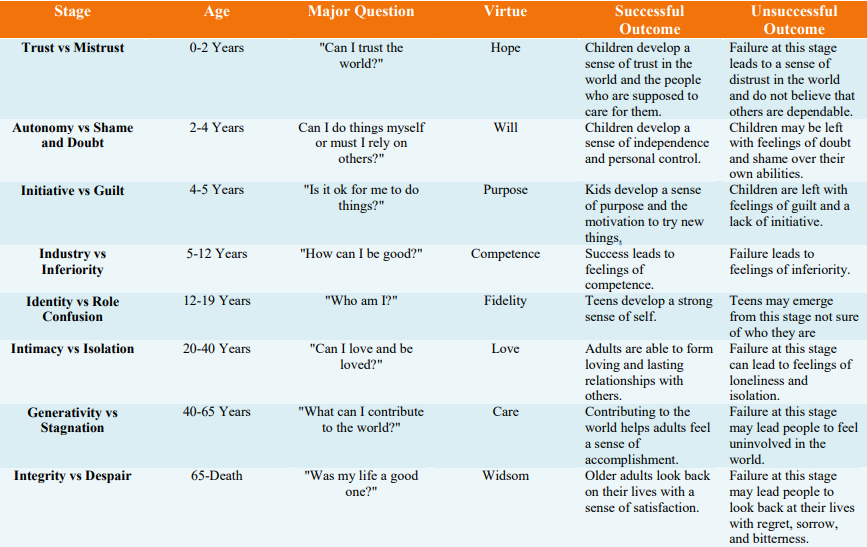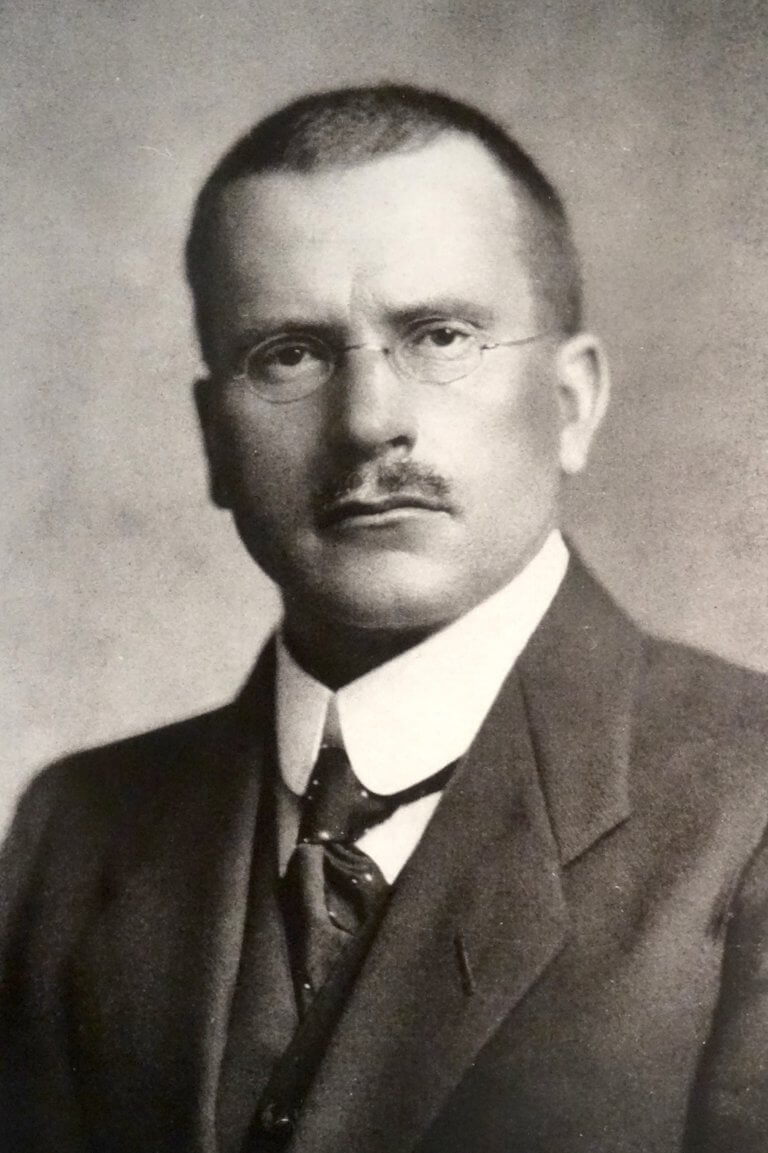Erikson’s Stages of Development
From infancy to adulthood, Erik Erikson’s psychosocial stages reveal how we face life’s challenges. Experts explore the milestones that shape our identities.

Erikson’s stages of development explain how personality develops and changes throughout the course of the entire lifespan. It is one of the major child development theories that has influenced our understanding of how kids develop through childhood and later life.

The eight stages in Erikson’s theory are:
- Trust vs Mistrust (infancy)
- Autonomy vs. Shame and Doubt (toddler years)
- Initiative vs. Guilt (preschool years)
- Industry vs. Inferiority (middle school years)
- Identity vs Role Confusion (adolescence)
- Intimacy vs. Isolation (young adulthood)
- Generativity vs. Stagnation (middle adulthood)
- Integrity vs. Despair (older adulthood)
This article discusses Erikson’s stages of development and explores the important events at each stage. It also covers the consequences of success and failure at each point in development.
An Overview of Erikson’s Stages of Development
As each person progresses through life, from infancy until death, they confront different challenges that can either be mastered or lead to difficulties. While each stage builds on the experiences of earlier stages, Erikson didn’t believe mastering each stage was necessary to move on to the next.
Like other stage theorists, Erikson believed these stages occurred in a predetermined order, a concept known as the epigenetic principle.
There are three key components of Erikson’s stages of development:
- Ego identity: This refers to our continually changing sense of self that emerges due to our social interactions and experiences.
- Ego strength: This quality develops when people successfully master each stage of development.
- Conflict: At each stage of development, people face some type of conflict that serves as a turning point in the developmental process.
Erikson’s 8 Stages of Development
Stage |
Age |
Major Question |
Virtue |
| Trust versus Mistrust | 0 – 2 Years | “Can I trust the world?” | Hope |
| Autonomy versus Shame and Doubt | 2 – 4 Years | “Can I do things myself or must I rely on others?” | Will |
| Initiative versus Guilt | 4 – 5 Years | “Is it okay for me to do things?” | Purpose |
| Industry versus Inferiority | 5 – 12 Years | “How can I be good?” | Competence |
| Identity versus Role Confusion | 13 – 19 Years | “Who am I?” | Fidelity |
| Intimacy versus Isolation | 20 – 40 Years | “Can I love and be loved?” | Love |
| Generativity versus Stagnation | 40 – 65 Years | “What can I contribute to the world?” | Care |
| Integrity versus Despair | 65 – Death | “Was my life a good one?” | Wisdom |
(Download a PDF version of this psychosocial summary chart).
Stage 1: Trust versus Mistrust
Is the world safe and predictable or dangerous and chaotic? Erikson believed that the first stage of psychosocial development was centered on answering this important question.
He also believed that this stage was the most important stage since it plays such a critical role in establishing how a person views and interacts with the world.
An infant enters the world completely helpless and dependent on caregivers to take care of it. Erikson believed that during these first two critical years of life, it is essential for an infant to learn that caregivers can be trusted to provide for these needs. When a child is cared for, and their needs are attended to properly, they develop a sense that the world is trustworthy.
What happens if a child is neglected or their needs are not met with any real consistency? In such a scenario, the child may develop a sense of mistrust of the world. The world may feel like an unpredictable place, and the people who should love and care for the child may not be dependable.
Key Points About Trust vs. Mistrust
- If this stage is completed successfully, the child will emerge with the virtue of hope.
- Even when challenges emerge, a person with this quality will feel they can turn to loved ones for support and care.
- Those who fail to gain this virtue will experience fear. When a crisis occurs, they may feel hopeless, anxious, and insecure.
Stage 2: Autonomy versus Shame and Doubt
As children enter the toddler years, they become increasingly independent. They not only begin to walk by themselves, but they also start to perform some actions independently. Kids often want to make more choices about the things that impact their lives, such as selecting which foods to eat and which clothes to wear.
These actions not only play an important role in becoming a more independent human being, but they also help determine whether children develop a sense of autonomy or feelings of doubt about their own abilities.
Those who successfully navigate this stage of psychosocial development will emerge with the virtue of will, or the sense that they can take meaningful actions that will influence what happens to them.
Kids who develop this autonomy will feel self-confident and comfortable being themselves. Caregivers can help ensure that kids succeed in this stage of encouraging choices, allowing kids to make decisions, and supporting this increased independence.
What actions might lead to failure at this stage? Parents who are overly critical, don’t allow their children to make choices, or are too controlling can contribute to shame and doubt. These children might emerge from this stage lacking self-esteem and confidence in their abilities and may become overly dependent upon others.
Key Points About Autonomy vs. Shame and Doubt
- This stage helps set the course for further development.
- Children who succeed in this stage will have a greater sense of their own independence.
- Those who struggle may feel shame related to their efforts and abilities.
Stage 3: Initiative versus Guilt
The third stage of Erikson’s theory is centered on kids developing a sense of initiative. Peers become more important at this point, as kids begin to interact more with kids in their neighborhood or in their classroom. Children begin to engage in more pretend play and social play, often making up games and planning activities with others kids.
At this stage, kids need to make judgments and plan their actions. Kids also assert more power and control over the world around them. Parents and caregivers should encourage children to explore and make appropriate decisions during this stage.
Key Points About Initiative vs. Guilt
- Kids who successfully master this stage emerge with a sense of initiative, while those who do not may experience guilt.
- The virtue at the center of this stage is purpose, or the sense that they have control and power in the world.
Stage 4: Industry versus Inferiority
During the school years before adolescence, children enter the psychosocial stage that Erikson referred to as industry versus inferiority. Throughout this stage, children are focused on developing a sense of competence. Not surprisingly, school plays an essential role during this phase of development.
As they mature, children become increasingly able to tackle more and more complex tasks. They are also interested in becoming more masterful and accomplished at various things, and express interest in learning new skills and taking on challenges.
Ideally, kids will receive encouragement and praise for performing different things such as drawing, reading, and writing. By receiving this positive attention and reinforcement, kids begin to build the self-confidence that they need to succeed in life.
So what happens if children do not get praise and attention from others for mastering new skills? Erikson believed that failing to master this stage of development would ultimately lead to feelings of inferiority and a lack of confidence in one’s own abilities. The basic virtue that emerges from successfully completing this psychosocial stage is known as competence.
Key Points About Industry vs. Inferiority
- Supporting and encouraging kids helps them learn new skills while gaining a sense of competence.
- Children who struggle during this stage may have problems with self-confidence as they grow older.
Stage 5: Identity versus Role Confusion
Anyone who remembers the often tumultuous teenage years can probably instantly understand Erikson’s identity versus role confusion stage of development.
At this point, adolescents begin to explore the basic question: “Who am I?” Teens focus on developing a sense of self, figuring out what they believe in, who they are, and what they want to become.
Erikson believed forming a personal identity was one of the most important phases of life. Developing a strong sense of self serves as a sort of compass that helps guide each person through the rest of their life.
So, what does it take to develop a good identity? First is the ability to explore with support and love. Kids often go through different phases and explore different ways of expressing themselves.
Key Points About Identity vs. Confusion
- Those who are allowed to go through this personal exploration and successfully master this stage emerge with a strong sense of independence, personal agency, and a sense of self.
- Those who fail to complete this stage often enter adulthood confused about who they are and what they want out of life.
- The basic virtue that emerges from completing this stage successfully is known as fidelity.
Stage 6: Intimacy versus Isolation
Love and romance are some of the primary concerns of many young adults, so it’s not surprising that the sixth stage of Erikson’s theory centers on exactly this topic. This stage begins around age 18 and 19 and continues to age 40.
The central theme of this stage is centered on forming loving, lasting, and supportive relationships with other people. Erikson believed that the sense of self that was (hopefully) established during the identity versus role confusion stage plays a vital role in being able to forge strong and loving relationships.
Key Points About Intimacy vs. Isolation
- Success during this phase of development leads to strong bonds with others, while failure can result in a sense of isolation and loneliness.
- The basic virtue that develops at this stage is love.
Stage 7: Generativity versus Stagnation
The later years of adulthood are marked by a need to create something that will continue after we are gone. Essentially, we feel the need to leave a lasting mark on the world.
This can involve raising children, taking care of others, or having some positive impact on other people. Careers, family, church groups, community organizations, and other things can all help contribute to this sense of accomplishment and pride.
Key Points About Generativity vs. Stagnation
- Those who master this stage of development emerge with a sense that they have made a significant and valuable impact on the world around them and developed the basic virtue that Erikson referred to as care.
- People who do not manage this stage effectively may feel uninvolved, unproductive, and even cut off from the world.
Stage 8: Integrity versus Despair
The final stage of Erikson’s stages of development lasts from approximately age 65 up until the end of a person’s life. While it may be the last stage of life, it is still important. It is during this time that people begin to reflect back on the life that they have lived and ask, “Did I live a good life?”
People who reflect back on their lives with a sense of pride will feel fulfilled, while those to look back with regret will experience bitterness or even despair.
Key Points About Integrity vs. Despair
- People who master the final stage of life emerge with a sense of wisdom and feel that they have lived a worthwhile and meaningful life even though they face death.
- Those who feel their lives were wasted or meaningless will experience sadness, anger, and regret.
Comparing Erikson’s and Freud’s Theories
Erikson’s theory bears some resemblances to Freud’s psychosexual stage theory, but with some key differences.
Erikson’s Theory
- Erikson’s theory focused on the ego.
- Erikson’s theory spans the entire lifespan.
- Erikson placed a greater emphasis on the role of social and cultural influences.
Impact of Erikson’s Stages of Development
Erikson’s stages of development marked a significant change from a lot of earlier theories in that the theory focused on development across the entire lifespan. Today, many psychologists prefer theories that are less focused on a set of predefined stages. They also recognize that individual differences and varied experiences often mean that development can be markedly different from one person to the next.
Some common criticisms of Erikson’s stages of development include:
- The theory doesn’t say much about the underlying causes of each development crisis.
- It also tends to be somewhat vague about the different experiences and events that mark the difference between success and failure at each stage.
- The theory lacks an objective way to determine if a person has “passed” or “failed” a particular stage of development.
- Many events are not restricted to a single stage; for example, research has shown that identity formation continues well beyond adolescence into adulthood.
Frequently Asked Questions
How do Erikson’s stages of development differ from Freud’s?
While they share some similarities, Erikson’s theory focuses on how social experiences shape development and describes how people change and grow throughout life.
What is the epigenetic principle?
The epigenetic principle suggests that development occurs in a series of predetermined stages.
What are the three key elements that make up the psychosocial theory?
Erikson believed that each stage is marked by conflicts that contribute to the development of ego identity and psychological virtues.
Sources:
Erikson EH. Childhood and Society. New York: Norton; 1950.
Erikson EH. Identity and the Life Cycle. New York: International Universities Press; 1959.
Erikson EH. Identity: Youth and Crisis. New York: Norton; 1968.
Malone JC, Liu SR, Vaillant GE, Rentz DM, Waldinger RJ. Midlife Eriksonian psychosocial development: Setting the stage for late-life cognitive and emotional health. Dev Psychol. 2016;52(3):496-508. doi:10.1037/a0039875
Meeus W, van de Schoot R, Keijsers L, Branje S. Identity statuses as developmental trajectories: A five-wave longitudinal study in early-to-middle and middle-to-late adolescents. J Youth Adolesc. 2012;41(8):1008-1021. doi:10.1007/s10964-011-9730-y
Orenstein GA, Lewis L. Eriksons Stages of Psychosocial Development. In: StatPearls [Internet]. Treasure Island (FL): StatPearls Publishing.





